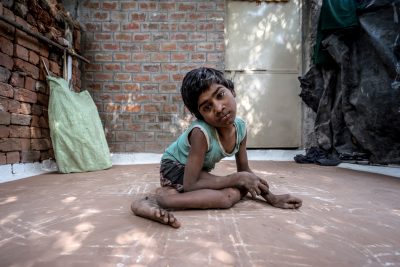
SURAJ Malam Singh reached adulthood without ever having caught a ball, sung a song or climbed a tree. At 18 years of age, Suraj had never run or jumped, had never stood up unaided, hadn’t once walked a single, self-sovereign step. By the time he could vote, Suraj had not uttered one word. Limbs twisted, trapped in a speechless void, unable to reach out, Suraj was best known for one thing: his enormous, brilliant smile. The person behind this delighted grin was an enigma, until, just months ago, something impossible began to happen.
THE LURE of regular work drew Suraj’s parents Ramsiya Bai and Malam Singh away from Vidisha, a city ancient enough to be in the Mahabharata. Here, a prismatic sandstone pillar looms over single-story houses made of straw, clay, dung and tiling. Commissioned by a Greek ambassador over two millennia ago, the column attests to the international reach of a powerful lost kingdom, one whose trading centre was once governed by the future Ashoka the Great. This wasn’t trade as we know it now, though. Words inscribed on the pillar’s base advise that conduct follow three “immortal footsteps”: self-restraint, charity, consciousness.
High literacy rates hint at Vidisha’s former pre-eminence but today it’s one of a number of poorer districts across Madhya Pradesh frequently abandoned for metropolitan Bhopal and the promise of a better life.
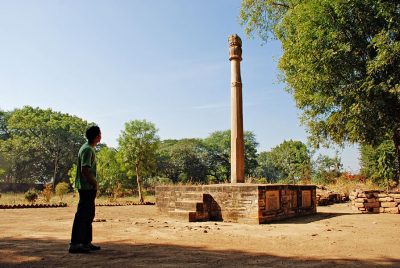
RAMSIYA AND Malam arrived a quarter-century ago in urgent need of cut-price land for a new home. They found none was cheaper than that in Gareeb Nagar (literally, “Poor Town”). “If we had had more money”, Ramsiya says, “we might have bought a plot in a better area.” They didn’t, so they paid Rs. 1000 (£11.50) and began constructing a small, two-roomed hut.
We described their home in a 2007 newsletter (15 years later): Ramsiya’s house is like many others, a hovel built of whatever materials came to hand. In it you may detect the debris of a sub-civilisation, its walls include jute sacking, palm fronds, planks, beaten-flat cans, rubber tyres, frayed plastic sheets.
Two years earlier, visiting Sambhavna health staff carefully noted the milestones Suraj had missed by the age of seven. At one year he hadn’t sat up or recognised his mother. By three, no response to speech. Meeting Suraj at eight, managing trustee Sathyu wrote, “He melts my heart, but does not, cannot, speak. His legs, arms too, are mostly useless, but he makes amazing use of them, dragging himself about, crawling, tumbling, using his limbs as though he’s trained each separately. There are sores on his knees, ankles, shins. Flies cluster on them. Suraj, unmindful, smiles on.”
“Suraj is so naughty,” Ramsiya told Sathyu. “He won’t sit still, he drags himself around, wanting to play with other children.” It was round-the-clock toil simply to keep Suraj from danger.
As in Vidisha, situated by a fork of the Betwa and Bes rivers, there was deep water nearby. But whereas the Betwa serves as a haven for endangered birds, the murky lagoon 150 feet from Suraj’s front yard — manmade, motionless and shaped like a swollen ‘π’ — harbours no waterfowl, rare or otherwise. A severe drought once left Vidishi’s astonished to find that the large stone outcrop used by generations of bathers wasn’t a ghat but a God, face-down in the mud, centuries-forgotten. Next to Gareeb Nagar, the dry season instead exposes tattered strips of black polyethylene, dark rainbow pools and the reek of something unholy.
THIS IS the largest of Union Carbide’s ‘solar evaporation ponds’ — the “most economical solution” to the lack of a Bes or Betwa river into which to pour the tens of thousands of gallons of liquid wastes the Bhopal factory would produce. Two decades before Ramsiya and Malam moved into the area, American engineers tasked with designing these artificial lakes worried they would not be able to “prevent seepage of the chloride into the ground waters and therefore into the community water supply.”
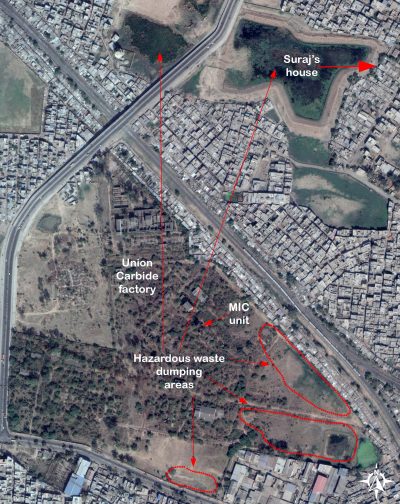
“I cannot believe,” wrote one, “that we at the Tech Center would be held blameless if we recognize potential problems here and did not speak up”. So they spoke, advising higher US management that “new ponds will have to be constructed at 1-2 year intervals throughout the life of the project”.
But the dark lake lying next to the house in which Suraj was born never was rebuilt. In January 1977, a few days before a ‘Revised Capital Budget’ proposed sweeping cutbacks across the Bhopal factory, Carbide managers met with contractors hired to build the ponds. Though the company knew that the neutralised acids, saline and lab wastes to be pumped into it presented “drinking water pollution hazards”, managers informed the builders “that certain seepage/effluent from the pond can be accepted… providing there is corresponding reduction in the cost.”
Leaks ensued soon enough. Monsoon rains caused overflows, decanting toxic liquor into porous soil. Polyethylene liners began to perish. Cattle deaths prompted pay-offs to farmers. A panicky 1982 telex from India to Carbide’s US headquarters described how one pond showed “signs of leakage”, while another had “almost emptied”. A later telex wrote of “continued leakage”. Replies promised “close attention by the management committee in New York,” but the ponds were left in situ, their liners unreplaced.
TEN YEARS later, Ramsiya began drawing water from a long-handled, cast iron handpump that pierced ground just yards from Carbide’s main pond — a chemical dump whose “essence”, as a design engineer noted in 1972, “lies in the less advanced environmental conscienceness [sic] in India.”
“The water was often a dirty brown colour,” Ramsiya remembers. “It smelled and tasted really bad, like someone had added medicine. When you drank you’d feel burning in your throat. Sometimes people got stomachaches, sometimes fevers.”
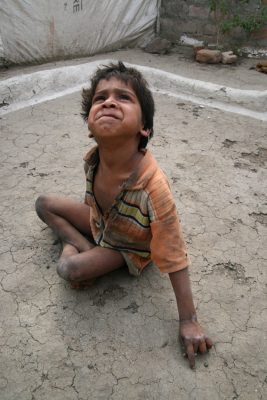
In 1990, independent lab tests on pond sediments and nearby soil and well water (organised by the Bhopal Group for Information and Action) found samples to be lavishly contaminated with pthalates, I-napthalene, benzene, and organochlorines like di- and tri-chlorobenzenes. As the news reached local press, Carbide director Bose sent a hectoring letter to State officials branding the reports “mischievous and designed to cause panic” and demanding that officials “remove unnecessary apprehension in [from] the minds of the public”.
It would be another six years before authorities painted Gareeb Nagar’s handpump red, declaring its water unfit for human consumption. Nonetheless, Ramsiya kept on using it. “There was nothing else for us to drink. What could we do? We had to keep drinking that poisoned water.”
Only after Suraj’s 1998 birth did Ramsiya learn from neighbours that pond water was mixing with the groundwater she’d already been drinking for years. And none in her community yet knew that Gareeb Nagar’s water may by then have been holding other, even darker secrets.
RAMSIYA RECALLS the time she began to suspect all was not well. “When I put baby Suraj’s head on my shoulder, his neck was so loose I felt it would break.” She raises a question for which there is no adequate response. “Maybe Suraj was born like this because of the water?”
Less than half a mile south-west of the main Gareeb Nagar handpump towered a modern relic of international trade — the rectangular tangle of rusting iron and steel that Carbide’s lethal MIC unit had by now become. A few years before Ramsiya made her home in Bhopal, Carbide undertook tests on contaminated soil and water taken from the decaying site. The samples caused “100% mortality” to fish.
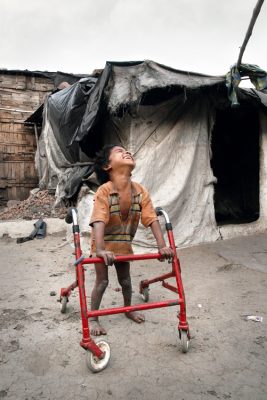
Done “primarily for our own understanding of the situation”, the tests revealed the spreading environmental impact of 21 dump sites inside the plant. Here, thousands of tons of solid toxic wastes had been indiscriminately buried in unlined pits. The explosive results confirmed that contaminants had spread beyond the factory’s perimeter to begin impacting community wells. But even after learning that the hydro-geology of the Betwa river basin, on which the factory stood, steered underground flows north by north-east, directly toward rapidly growing poor communities, where lived thousands of families like Suraj’s, Carbide kept their results “business confidential’.
Desperate to find answers, Ramsiya carried Suraj to numerous doctors. Finally, at Hamidia hospital, she received devastating news. “Doctor Sahib told me that Suraj’s brain has not developed properly, and that there was no treatment for his disease.”
Suraj was four by the time Carbide’s secret tests were dragged into the light via a New York court. He was belatedly weaned that year — the same year the NGO Shristi found chloroform, mercury, lead, pesticides and dichloromethanes in the milk of mothers living by the factory. Meanwhile, State pollution officials identified a slew of poisons in Gareeb Nagar’s well water — tri-chlorobenzenes, lindane, DDT, endosulfan.
When photographer Micha Patault visited nine-year-old Suraj to take the photos you see here, he found him crawling alone, unable to speak, unable to play. “Suraj is mentally backward”, Micha wrote bluntly. “The doctors can do nothing for his case.”
Suraj’s cover image was taken in December 2015. Gone are the ramshackle hutment, the cracked mud floor — Suraj sits in a clean yard before a home of brick and mortar. His pose is familiar, the sores remain, but Suraj’s famous smile is also no longer there.
WHAT IS A MIRACLE? Scholars say that it is as wondrous to see the support of a family for somebody in trouble as it is to witness the parting of the Red Sea. This alone is the miracle of Suraj Singh. Few believed it would so quickly become so much more.
Before Suraj reached 18 years of age, Chingari community worker Shankar knocked on Ramsiya’s door. A decade earlier, Suraj had been part of Chingari’s first intake, but a clash of duties forced Ramsiya to end their visits.
Chingari had evolved since 2006, Shankar explained. Ramsiya didn’t need to travel: Suraj would be collected each morning, he’d be given a square meal and brought home each afternoon. Suraj could receive professional care. All would be entirely free of cost.
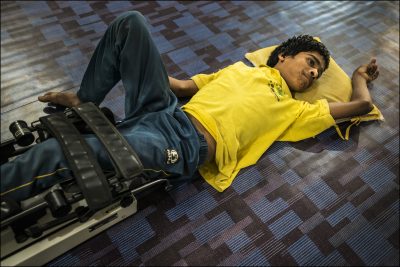
“A mother has to face all the problems — I’ve fed and bathed Suraj with my own hands,” says Ramsiya of her years spent coping. “Wherever Suraj sat he peed and poo‘ed. I had to clean him and wash his clothes each time” Her efforts left Ramsiya unable to earn, the family reliant on Malam’s daily-wages. After nearly half-a-lifetime of care work, Ramsiya says, “I had accepted our fate”.
“Suraj couldn’t hold his neck up and would fall back just trying to sit,” says our physiotherapist Rishi of initial assessments. “His muscles were highly stiff, with less real chance of improvement.”
Neither Chingari nor Suraj were deterred. Three painstaking months of targeted therapy, six days per week, enabled Suraj to gain some neck control. Next came three months dedicated work strengthening his torso. A month after, Suraj sat without support for the first time. Now began motion therapy work on the lower limbs: stretches gauged by the finest degrees, a glacially slow millimetre at a time. After months of unflinching effort, Suraj was able to stand. Balance and coordination work came next.
The frames you see opposite immortalise, at 19 years of age, Suraj’s first unaided footsteps. Witnesses left in tears. 116 other Chingari kids had walked before him, none so impossibly.
One morning last year, after six months of speech therapy, Suraj turned to Ramsiya. With careful effort he forced his lips to close and open on the first word of his 19 years of life. ‘Amma,’ he said.
Reaching Chingari these days, Suraj often stands to walk past the office door. “Arey, hero!” someone shouts. Suraj raises an arm in the air, and opens his luminous smile.
THE POISONING of Bhopal’s groundwater was anticipated, approved, reviewed, tested, confirmed and still left to develop. No warnings came, no clean-up. The only thing carefully disposed of was consciousness of the approaching danger to people like Ramsiya, Malam & Suraj.
A seventeen-year struggle for legal redress within a hostile New York court ended two years ago. “Sahu and many others living near the Bhopal plant may well have suffered terrible and lasting injuries from a wholly preventable disaster for which someone is responsible,” the court admitted. “Union Carbide Corporation,” it then declared, shockingly, perversely, “is not that entity.”
Carbide’s poisons are thus left to radiate outwards, to reach ever new wells, ever new wombs. Until recently, 22 communities — over 50,000 people — were officially exposed to toxic water. Days ago, a national institute revealed the results of tests on the wells of a further 20 colonies, some lying over five km from the factory. These confirmed the presence of nitrates, chloride, heavy metals and alpha naphthol, a chemical used in the manufacture of MIC.
And so Chingari & Sambhavna’s care of water-poisoned families like Suraj’s — able now to walk 20 steps & call his mother’s name — grows daily more vital, just like your magical support, which reaches around the earth to help bring miracles to the margins of hope.
Watch the incredible moment when Suraj takes his first ever steps, in the corridor at the Chiungari Trust Rehabilitation Centre.



